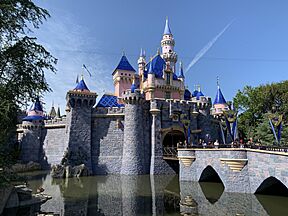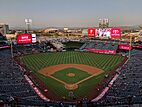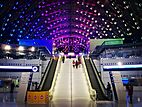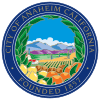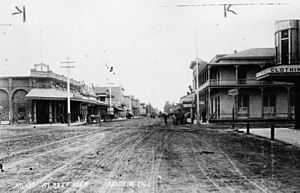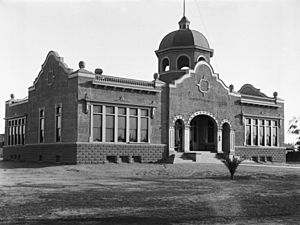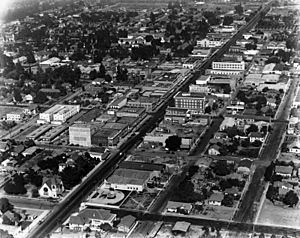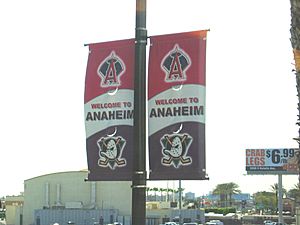Anaheim, California facts for kids
Quick facts for kids
Anaheim, California
|
|||
|---|---|---|---|
|
|||
| Etymology: "Ana", from the Santa Ana River, and | |||
| Country | United States | ||
| State | California | ||
| County | Orange | ||
| Founded | 1857 | ||
| Incorporated | March 18, 1876 | ||
| Government | |||
| • Type | Council–manager | ||
| • Body | Anaheim City Council | ||
| Area | |||
| • Total | 50.88 sq mi (131.78 km2) | ||
| • Land | 50.27 sq mi (130.20 km2) | ||
| • Water | 0.61 sq mi (1.58 km2) | ||
| Elevation | 157 ft (48 m) | ||
| Population
(2020)
|
|||
| • Total | 346,824 | ||
| • Rank | 56th in the United States 10th in California |
||
| • Density | 6,899.22/sq mi (2,663.78/km2) | ||
| Time zone | UTC−08:00 (PST) | ||
| • Summer (DST) | UTC−07:00 (PDT) | ||
| ZIP codes |
92801–92809, 92812, 92814–92817, 92825, 92850, 92899
|
||
| Area codes | 657/714 | ||
| FIPS code | 06-02000 | ||
| GNIS feature IDs | 1652663, 2409704 | ||
Anaheim is a large city in Orange County, California, in the United States. It's part of the greater Los Angeles area. In 2020, about 346,824 people lived there, making it the biggest city in Orange County. It's also the 10th largest city in California.
Anaheim is famous for being home to the Disneyland Resort, a huge fun park. It also has the Anaheim Convention Center, where many big events happen. Plus, it's where two professional sports teams play: the Los Angeles Angels (baseball) and the Anaheim Ducks (hockey). From 1980 to 1994, the Los Angeles Rams (football) also played here.
The city was started in 1857 by 50 German families. It became an official city in 1876. For a long time, Anaheim was mostly a farming community. But everything changed when Disneyland opened in 1955. This brought many hotels and new homes to the area. Anaheim also became a place where electronics, airplane parts, and canned fruit were made.
Anaheim stretches across Orange County, from Cypress in the west to the Riverside County line in the east. It has many different neighborhoods. Some areas have older homes, while others are busy commercial centers. The Disneyland Resort is a big part of the Anaheim Resort district, which has many hotels and shops. There's also the Platinum Triangle, a modern area around Angel Stadium with plans for tall buildings. Further east, Anaheim Canyon is a large industrial area. The eastern part of the city, Anaheim Hills, is a planned community with open spaces.
Contents
- What's in a Name? The Story of Anaheim
- Anaheim's Past: A Journey Through Time
- Anaheim's Location and Look
- Who Lives in Anaheim?
- Anaheim's Economy: How the City Makes Money
- Fun Things to Do in Anaheim
- Anaheim's Sports Teams
- City Services and Infrastructure
- Learning in Anaheim
- Getting Around Anaheim
- Famous People from Anaheim
- Sister Cities
- See also
What's in a Name? The Story of Anaheim
The name Anaheim is a mix of two words. "Ana" comes from the nearby Santa Ana River. "Heim" is a German word that means "home." So, Anaheim means "home by the Santa Ana River." You can find "heim" in many German place names, like "Trondheim" in Norway.
Anaheim's Past: A Journey Through Time
Early Days with the Tongva People
Long ago, the Tongva people lived in the area where Anaheim is now. They have been here for thousands of years, since about 3500 BCE. Their village in Anaheim was called Hutuukuga. It was one of the largest Tongva villages. They used plants like oak trees and sage for food. They also hunted rabbits and deer. The Tongva people traded with other villages near the coast and further inland.
Spanish and Mexican Influence
The land that is now Anaheim was once part of a large Mexican ranch called Rancho San Juan Cajón de Santa Ana. This land was given to Juan Pacífico Ontiveros in 1837. Later, in 1857, Ontiveros sold about 1,160 acres of his land. He sold it to 50 German-American families who wanted to start a new community.
How Anaheim Was Founded
In 1857, 50 German-American families from San Francisco decided to create a new town. They were looking for a good place to grow grapes. They bought a large piece of land in what is now Orange County.
The group formed the Anaheim Vineyard Company. Their new community was first called Annaheim, meaning "home by the Santa Ana River" in German. Later, the name changed to Anaheim. Their Spanish-speaking neighbors called it Campo Alemán, which means "German Field."
Most of the settlers were not farmers; they were mechanics and craftsmen. But they wanted to grow grapes and make wine. They set aside land for a town center, and the first building they built was a school. The first home was built in 1857. Anaheim became the biggest wine producer in California for 25 years.
However, in 1884, a plant disease destroyed all the grapevines. So, the farmers started growing other crops like walnuts, lemons, and oranges. These fruits and vegetables became important when the area got connected to the railroad in 1887.
Helena Modjeska: A Famous Resident
A famous Polish actress named Helena Modjeska lived in Anaheim. She became good friends with Clementine Langenberger. Today, Helena Street and Clementine Street in Anaheim are named after these two friends. Modjeska Park in West Anaheim is also named after Helena Modjeska.
Anaheim in the Early 1900s
In the early 1900s, Anaheim was a big farming area with many orange groves. Landowners like Bennett Payne Baxter helped the community grow. He found new ways to water orange groves and shared his ideas. Baxter Street is named after him.
Rudolph Boysen was Anaheim's first Park Superintendent. He created a new type of berry. Later, Walter Knott named this berry the boysenberry, after Rudy Boysen. Boysen Park in East Anaheim is also named for him.
In the 1920s, some groups tried to change how the city was run. They wanted to make strict rules about alcohol. But the community worked together to make sure everyone was treated fairly. The people who wanted to make strict rules were removed from power in 1925.
Disneyland and Modern Anaheim
The Disneyland theme park started being built in 1954 and opened on July 17, 1955. It quickly became one of the most popular places to visit in the world. Over 650 million people have visited Disneyland since it opened! Before Disneyland, the area was just orange and walnut trees.
Disneyland's opening brought a huge tourism boom to Anaheim. Many hotels, restaurants, and shops were built around the park. This turned the area into a lively place with lots of lights and attractions.
In the mid-1960s, Anaheim's growth attracted a Major League Baseball team, the California Angels. They moved to Anaheim in 1966. In 1980, the National Football League's Los Angeles Rams also played in Anaheim until 1995. In 1993, Anaheim got its own National Hockey League team, the Mighty Ducks of Anaheim.
In the 1990s, the area around Disneyland was renamed the Anaheim Resort. This district includes the Disneyland Resort, the Anaheim Convention Center, the Honda Center, and Angel Stadium of Anaheim. The area was improved with new signs and wider, tree-lined streets.
Anaheim in the 21st Century
In 2001, Disney California Adventure Park opened, which was a big expansion for Disneyland. In 2007, Anaheim celebrated its 150th birthday.
Anaheim's Location and Look
Anaheim is about 25 miles (40 km) southeast of downtown Los Angeles. The city stretches along the 91 Freeway. It borders cities like Yorba Linda, Placentia, Fullerton, and Buena Park to the north. To the west, it borders Buena Park and Cypress. To the south, it borders Stanton, Garden Grove, and Orange.
City Areas
Anaheim has several important areas:
- The Anaheim Resort is the area around Disneyland.
- Anaheim Canyon is a large industrial area.
- The Platinum Triangle is the area around Angel Stadium, planned for new buildings.
- Anaheim Hills is a planned community in the eastern part of the city.
- The Anaheim–Santa Ana edge city is a large commercial area that connects Anaheim with nearby cities like Orange and Santa Ana.
Weather in Anaheim
| Weather chart for Anaheim, California | |||||||||||||||||||||||||||||||||||||||||||||||
|---|---|---|---|---|---|---|---|---|---|---|---|---|---|---|---|---|---|---|---|---|---|---|---|---|---|---|---|---|---|---|---|---|---|---|---|---|---|---|---|---|---|---|---|---|---|---|---|
| J | F | M | A | M | J | J | A | S | O | N | D | ||||||||||||||||||||||||||||||||||||
|
3.3
71
49
|
3.5
71
49
|
1.9
74
51
|
0.8
77
53
|
0.5
78
58
|
0.2
82
62
|
0.1
87
66
|
0.1
89
66
|
0.1
88
64
|
0.7
83
59
|
1
77
53
|
2
71
48
|
||||||||||||||||||||||||||||||||||||
| temperatures in °F precipitation totals in inches |
|||||||||||||||||||||||||||||||||||||||||||||||
|
Metric conversion
|
|||||||||||||||||||||||||||||||||||||||||||||||
Anaheim has a warm, dry climate. Winters are mild with some rain, and summers are hot and mostly dry. The highest temperature ever recorded in Anaheim was 115°F (46°C) in July 2018. The lowest was 30°F (-1°C) in February 1990 and January 2002.
Who Lives in Anaheim?
Anaheim is a very diverse city. In 2020, the population was 346,824. About 53.8% of the people were of Hispanic or Latino background. Many different cultures and backgrounds make up the city's population.
Anaheim's Economy: How the City Makes Money
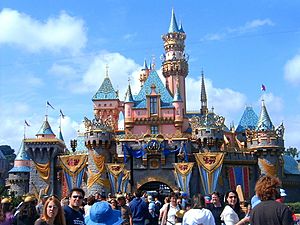
Anaheim's economy relies a lot on tourism. The Walt Disney Company is the biggest employer in the city. The Disneyland Resort brings in about $4.7 billion each year to Southern California. It also provides $255 million in taxes every year.
The Anaheim Convention Center is another big draw for visitors. It hosts many important national meetings and events. Many hotels in the city's Resort district serve tourists and people attending conventions.
The Anaheim Canyon business park is the largest industrial area in Orange County. It has many businesses and factories.
Major Companies in Anaheim
Several well-known companies have offices or headquarters in Anaheim:
- Anaheim Memorial Medical Center
- AT&T
- Banco Popular
- CKE Restaurants (parent company of Carl's Jr.)
- Disneyland Resort
- Extron Electronics
- Fisker Automotive
- Fujitsu
- General Dynamics
- Hewlett-Packard
- Isuzu North American headquarters
- Kaiser Foundation
- L-3 Communications
- Living Stream Ministry
- Pacific Sunwear
- Panasonic
- Pendarvis Manufacturing
- Raytheon
- Sunny Delight
- Targus
- Tenet Healthcare
- Toyota Financial Services
- YKK (zipper manufacturer)
- Yogurtland
- Zyxel
Top Employers
Here are some of the biggest employers in Anaheim:
| # | Employer | # of employees |
|---|---|---|
| 1 | Disneyland Resort | 36,000 |
| 2 | Kaiser Foundation Hospital | 4,500 |
| 3 | OC Sports & Entertainment | 2,000 |
| 4 | Northgate González Markets | 1,000 |
| 5 | Hilton Anaheim | 900 |
| 6 | Anaheim Regional Medical Center | 885 |
| 7 | L-3 Harris Technologies | 850 |
| 8 | West Anaheim Medical Center | 740 |
| 9 | Angels Baseball | 700 |
| 10 | Anaheim Marriott | 550 |
Shopping in Anaheim
Anaheim has many places to shop. Some of the larger shopping areas include:
- Downtown Disney at the Disneyland Resort
- Anaheim Plaza
- Anaheim Town Square
- Anaheim GardenWalk (a place with shops, restaurants, and entertainment)
Fun Things to Do in Anaheim
Anaheim has many attractions for everyone to enjoy:
- American Sports Centers (home to U.S. national volleyball teams)
- Anaheim Convention Center
- Anaheim GardenWalk
- Anaheim Hills Golf Course
- Anaheim Founders' Park
- Anaheim Ice (ice skating rink)
- Anaheim/OC Walk of Stars
- Angel Stadium of Anaheim (baseball park)
- Dad Miller Golf Course
- Disneyland Resort (includes Disneyland, Disney California Adventure, and Downtown Disney)
- Flightdeck Flight Simulation Center
- The Grove of Anaheim (a concert venue)
- Honda Center (sports arena)
- La Palma Park
- MUZEO (Art Museum)
- Oak Canyon Nature Center
Anaheim's Sports Teams
Anaheim is home to two major professional sports teams:
Current Teams
- NHL (hockey) team: Anaheim Ducks – They won the Stanley Cup in 2007.
- MLB (baseball) team: Los Angeles Angels – They won the 2002 World Series in 2002 when they were called the Anaheim Angels.
Past Teams
Many other sports teams have played in Anaheim over the years, including:
- NLL team: Anaheim Storm
- NFL team: Los Angeles Rams (played at Anaheim Stadium from 1980 to 1994)
- NBA team: Los Angeles Clippers (played some games here)
- Arena Football League team: Anaheim Piranhas and Los Angeles Kiss
- Roller Hockey International team: Anaheim Bullfrogs
- American Basketball Association team: Anaheim Amigos
- NBADL team: Anaheim Arsenal
- World Team Tennis: The Anaheim Oranges
- Continental Indoor Soccer League Team: The Anaheim Splash
- North American Soccer League team: California Surf
The Angels' Name Change
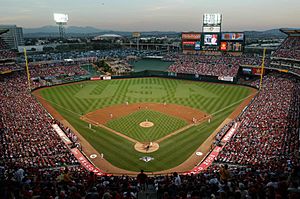
In 2005, the baseball team changed its name from the Anaheim Angels to the Los Angeles Angels of Anaheim. The team's owners wanted to market the team to all of Southern California. The "of Anaheim" part was kept to follow an agreement with the city.
The city of Anaheim felt this name change went against their agreement. They argued that the city had helped pay for stadium renovations, and the name "Anaheim" was important. Anaheim sued the team. After a long legal battle, the court decided in favor of the Angels team in 2006. The city appealed, but the decision was upheld in 2008. In 2009, Anaheim decided not to appeal any further, ending the dispute.
City Services and Infrastructure
Emergency Services
- Fire protection is handled by the Anaheim Fire Department. Disneyland Resort has its own fire department, but it also gets help from Anaheim's fire department.
- Law enforcement is provided by the Anaheim Police Department.
- Ambulance service is provided by Care Ambulance Service.
Anaheim Public Utilities
Anaheim Public Utilities provides water and electricity to homes and businesses. It's the only city-owned water and electric company in Orange County. The city council and a board of Anaheim residents help guide the utility's decisions. Anaheim is slowly burying its power lines underground to make the city look nicer and improve reliability.
Learning in Anaheim
Schools
Anaheim has many public school districts, including:
- Anaheim Elementary School District
- Anaheim Union High School District
- Centralia School District
- Magnolia School District
- Orange Unified School District
- Placentia-Yorba Linda Unified School District
- Savanna School District
There are 74 public schools in Anaheim, including elementary, junior high, and high schools. There are also private schools like Acaciawood Preparatory Academy and Servite High School.
Higher Education
Anaheim has two private universities: Anaheim University and Southern California Institute of Technology (SCIT). Community colleges also serve the area.
Libraries
Anaheim has eight public library branches where you can find books and other resources.
Getting Around Anaheim
Anaheim has many major roads that help people get around. Some of the main streets running east-west are Orangethorpe Avenue, Lincoln Avenue, and Katella Avenue. Major north-south streets include Beach Boulevard (SR 39), Harbor Boulevard, and State College Boulevard.
Several major highways also run through Anaheim:
- The Santa Ana Freeway (I-5)
- The Orange Freeway (SR 57)
- The Riverside Freeway (SR 91)
- The Costa Mesa Freeway (SR 55)
- The Eastern Transportation Corridor (SR 241 toll road)
Public Transportation
Anaheim is served by two main railroads: the Union Pacific Railroad and the BNSF Railway.
The Anaheim Regional Transportation Intermodal Center (ARTIC) is a big transit station near the Honda Center and Angel Stadium. It serves Amtrak trains, Metrolink commuter trains, and several bus companies. The Anaheim Canyon Metrolink station also serves Metrolink.
The Orange County Transportation Authority (OCTA) provides bus service throughout Anaheim and Orange County. The Anaheim Resort Transit (ART) offers shuttle service around the Disneyland Resort area.
Airports
Anaheim is about 15 miles (24 km) from both John Wayne Airport and Long Beach Airport. It's also easy to get to from Los Angeles International (30 miles / 48 km) and Ontario (35 miles / 56 km) airports.
Famous People from Anaheim
To learn about famous people who have lived in Anaheim, check out the List of people from Anaheim, California.
Sister Cities
Anaheim has two "sister cities" in other countries. These are cities that have special friendly relationships:
See also
 In Spanish: Anaheim para niños
In Spanish: Anaheim para niños


